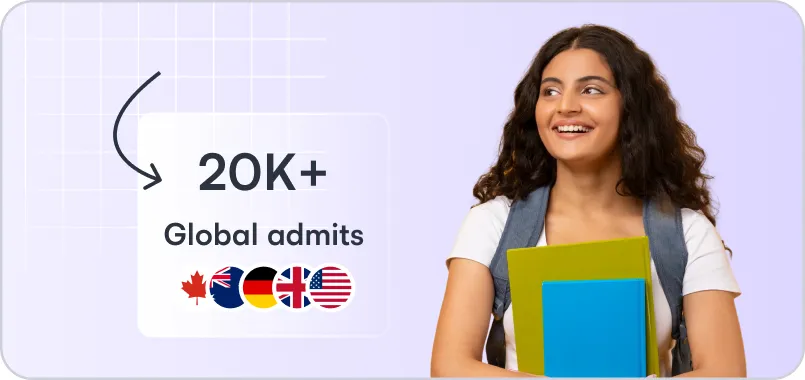It comes as no surprise that many overseas students aspire to study in the United States, considering the reputation of the nation as host to a broad array of prestigious higher education institutions. Fortunately, this is accomplished by the various student visa type in USA.
![]()
Here is a brief overview of the three categories of non-immigrant student visas available to receive a degree from the US.
F-Visa
International students who want to study for a degree at a recognized US university, as well as those who want to learn English at a school or intense English language course, are eligible for this type of US student visa.
There are 3 types of F-Visa:
- F1-Visa
- F2-Visa
- F3-Visa
Let us take a look at each one of these F1-Visa type that allows a student to study full-time at a US university.
F1-Visa
International students who wish to enrol in academic schools in the United States are granted an F1 visa. It contains multiple grades and levels ranging from elementary school through university and graduate school.
Register for F1 Visa Awareness Session⬅️
![]()
Requirements to get the Visa: Who can Apply?
- Must be accepted into an institution recognized by the Student Exchange Visitor Program (SEVP).
- Being a full-time student is a requirement.
- It will be more challenging to obtain an F1 visa if you can't demonstrate that you want to return home when your educational program is through.
- You must demonstrate that you have enough money in your savings accounts to pay for the costs of studying and residing in the US.
- Be able to speak English well; IELTS/TOEFL to prove English proficiency.
Documents Required
- Valid Passport
- Two Photographs
- Proof of payment of Visa application fees
- Form I-20
- Academic Credentials
- Results of standardized exams
- Proof of purchase of health insurance
How to apply?
- Obtain your admissions paperwork from the SEVP organization.
- Submit the DS-160 form online.
- Pay the application fee.
- Pay the SEVIS I-901 charge.
- Set a date for the F1 visa interview.
- Send the file including the necessary paperwork for an F1 visa.
- Attend the interview for a student visa.
Suggested: Managing the Cost for Studet Visa Abroad
M-Visa
The M-Visas are the second type of US student visa offered to foreign students who intend to attend a US institution for non-academic or vocational training.
There are 3 M-category US study visa types:
- M1-Visa
- M2-Visa
- M3-Visa
Let us take a look at the M1-Visa type that allows a student to enrol for vocational training in the US in greater detail.
M1-Visa
The duration of an M-1 student's admission to the US is set at the extent of their education program, including any supplementary vocational experience. Except in cases where extensions are granted for medical reasons, they cannot stay in the US for more than a year.
Requirements to get the Visa: Who can Apply?
- A student must be admitted to a school that is accepted by the Student Exchange Visitor Program (SEVP).
- It will be difficult to obtain M1-Visa if you can't show that you want to return home when your study program is through.
- You must show that you have sufficient funds in savings to cover the costs of studying and living in the US.
- Being able to communicate clearly in English; IELTS or TOEFL scores are acceptable proof.
Documents Required
- Valid Passport
- Two Photographs
- Proof of payment of Visa application fees
- Form I-20
- Academic Credentials
- Proof of financial stability
How to apply?
- Obtain the I-20 form.
- Submit the DS-160 form online.
- Pay the application fee.
- Pay the SEVIS I-901 charge.
- Set a date for the F1 visa interview.
- Send the file, including the necessary paperwork for an M1 visa.
- Attend the interview for a student visa.
Suggested: Difference between J1 and F1 Visa
J-Visa
J-Visas is for foreign students partaking in US programs that foster cultural exchange. All students must satisfy the program's qualifying conditions and be financed by a business or government organization, whether they are pursuing training in healthcare, industry, or another field.
There are 2 J-category student us visa type:
- J1-Visa
- J2-Visa
Let us take a further look at the J1-Visa which allows a student to study at an American institution as an exchange student.
J1-Visa
If J-1 visa holders are participating in a government-sponsored exchange program, pursuing medical school studies or training, or if their instruction is included on the Exchange Visitor Skills list, they will be subject to the two-year physical attendance obligation in their native land. As a result of this condition, those with J-1 visas must head home for a maximum of two years after their interchange visitor program has ended.
Requirements to get the Visa: Who can Apply?
There is different J1 student visa category USA for different individuals and different requirements:
- Au Pair and EduCare
- Camp Counselor
- Government Visitor
- Intern
- International Visitor
- Physician
- Professor and Research Scholar
- Short-term Scholar
- Specialist
- Student-school/university level
- Summer work Traveler
- Teacher trainee
All of the above can apply under an exchange program.
Documents Required
- Valid Visa
- Photograph
- Non-immigrant Visa Application form
- Visa Fee payment receipt
- Form DS-2019
- Form DS-7002
- J1 Visa Health Insurance
How to apply?
- Fill out your application form
- Obtain an interview with the embassy or consulate
- Pay the application fee
- Send the file including the necessary paperwork for a J1 visa
- Appear for the Interview
Suggested: Bank Balance for US Student Visa




